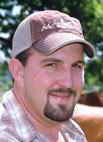
Some of the best family traditions come from not following the crowd and that is especially true with Tyler Rush. Like his father, Rocky Rush, this 25-year-old farmer maintains a profitable Red Angus herd consisting of 40 head on his 250-acre farm located a few miles east of Jasper, Mo.
“We had Red Angus when I was a kid so partly it’s because of what my dad had, but also partly because Red Angus has a really good heat tolerance. It’s a really good breed to get into,” said Tyler.
Tyler has added row cropping and hog raising to his cattle operations to keep the farm profitable. To maintain that diverse operation Tyler relies on the ease of maintenance and stayability of his Reds which translates into keeping all the eggs in his basket productive.
“The cattle fit right in,” noted Tyler. “It all flows together with the cattle and the crops so it’s how I can keep doing this, working for myself in farming.”
Adding to this flow, Tyler has built a sound herd of momma cows and bulls that has reduced the need for artificial insemination. “The reason we’re really going to natural breeding is because it’s a way to keep the costs down and we’ve got some really good bulls,” he explained. “Our herd’s sitting where we want them. We’ve got good milking cattle that produce good framed calves. We don’t have any problems with the momma cows raising those ‘kids.’”
The excellent mothering trait of his cattle coupled with outstanding fertility, birthing ease and continued hardiness of the Red Angus make for consistent production. “On the average I get about 36 to 38 calves every year,” noted Tyler. This year was right in the zone with 36 youngsters born to the herd.
To keep everything simple, manageable and repeatable with calving, breeding for the herd starts off typically in late May to accommodate Tyler’s calving time table of February with weaning hitting around September. He said, “I like to feed them out for a month or two after weaning, which is around September then sell them at the stockyards. When feeding the calves I do high corn rations.”
Rather than selling off all the new calves Tyler holds a few back in keeping with his practice of working with the excellent foundation he has built over the years. “I’ll sell the bulk of my herd sometime after the first of January, but I like holding back five or six heifers for replacement females for the next year,” he said. “I like keeping them because I know what bulls and cows they are out of.”
Having a streamlined nutrition and health management system has been made easier with a breed like the Red Angus. They have proven to have a more efficient conversion of forage leading to a higher quality carcass while being highly resistant to disease. These areas alone have aided Tyler to establish savings through lowering his overhead of time and expenses.
Normally Tyler only has to apply the basics when it comes to vaccinations to protect the herd and keep the goal of a solid, marketable calf. “I usually vaccinate twice a year using Ivomec with doing injectable one time and then pour-on,” commented Tyler. “ The calves, I like giving them two rounds of shots one before weaning then another two weeks after weaning which helps make them more marketable.”
Further savings for Tyler come with the abundance of water on his farm and quality forage maintained with best practices in paddock rotation keep his cattle well fed. Since his farming operation produces sufficient crops to support both his hogs and cattle Tyler avoids having to outsource feed. “The only thing I really end up buying to boost the herd is mineral supplements,” he noted.
Stress is a two-way street in beef cattle production that, if left uncheck can lead to lower returns at the market. Not only does maintaining a herd of well nourished cattle lend itself to less stress physically, Tyler’s Red Angus abates stress with their excellent disposition. “The temperament of all our cattle is really good. When you have calm cattle you don’t have to be stressed out and scared that they’ll be coming at you,” he said.
Looking down the road, Tyler sees a continuing relationship with the Red Angus breed with hopes to expand the herd as resources become available. “I’d like to keep what I’ve got and keep going with what I’ve got. If I find more land I’d like to expand, but it’s hard to come by. So we’ll just go from there and build more on both the cattle and crop operations,” forecasted Tyler.







